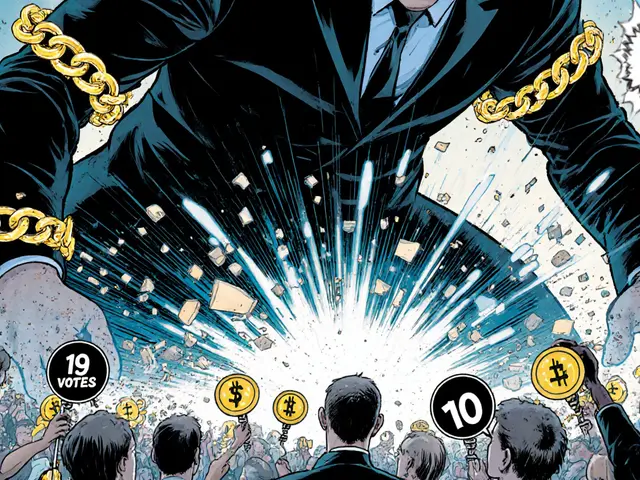- Home
- Cryptocurrency
- Understanding Bitcoin Futures Trading: How It Works

Understanding Bitcoin Futures Trading: How It Works
Bitcoin Futures Calculator
Futures Trading Simulator
This calculator demonstrates how leverage affects your potential profits and losses in Bitcoin futures trading. Enter values below to see how different scenarios play out.
Results
Enter values and click calculate to see results
Contract Comparison
| Attribute | Standard (5 BTC) | Micro (0.1 BTC) |
|---|---|---|
| Contract Size | 5 Bitcoin | 0.1 Bitcoin |
| Typical Notional Value (USD) | ≈ $150,000 (at $30,000/BTC) | ≈ $3,000 (at $30,000/BTC) |
| Initial Margin Requirement | 35-45% of notional | 30-40% of notional |
| Leverage Potential | ≈ 2-3× | ≈ 2-3× |
| Typical Traders | Institutions, professional prop firms | Retail traders, smaller accounts |
When you hear about Bitcoin futures trading is a cash‑settled derivative that lets you bet on Bitcoin’s price without owning the actual coin, you might wonder how it actually functions. In simple terms, you’re signing a contract that promises to pay or receive the difference between the price you locked in and the price at settlement. The whole process runs on regulated exchanges, offers leverage, and works almost 24/7, making it a popular tool for both speculation and hedging.
What Exactly Are Bitcoin Futures?
Bitcoin futures are financial contracts whose value is derived from the price of Bitcoin. Unlike buying the cryptocurrency itself, futures let you gain exposure without storing private keys or worrying about wallet security.
The first regulated Bitcoin futures were launched by the Chicago Mercantile Exchange (CME) in December 2017. The contracts are overseen by the U.S. Commodity Futures Trading Commission (CFTC), which provides institutional‑grade oversight.
How Do Bitcoin Futures Work?
Every futures contract specifies a size, an expiration date, and a settlement method. The most common CME contract represents 5Bitcoin, while the newer micro contract represents 0.1Bitcoin, giving traders flexibility to scale their positions.
When the contract expires, it is cash‑settled. That means instead of delivering actual Bitcoin, the exchange pays the net difference in U.S. dollars based on the final settlement price. The settlement price is calculated using the CME CF Bitcoin Reference Rate (BRR), which aggregates prices from major Bitcoin spot exchanges during a predefined 15‑minute window.
Because settlement is cash‑based, you never have to move Bitcoin on‑chain, and the clearing house guarantees the contract’s performance. This structure appeals to traditional financial firms that are prohibited from holding the cryptocurrency itself.
Contract Types: Standard vs. Micro
Below is a quick side‑by‑side comparison of the two most popular CME contracts.
| Attribute | Standard (5BTC) | Micro (0.1BTC) |
|---|---|---|
| Contract Size | 5Bitcoin | 0.1Bitcoin |
| Typical Notional Value (USD) | ≈$150,000 (at $30,000/BTC) | ≈$3,000 (at $30,000/BTC) |
| Initial Margin Requirement | 35‑45% of notional | 30‑40% of notional |
| Leverage Potential | ≈2‑3× | ≈2‑3× |
| Typical Traders | Institutions, professional prop firms | Retail traders, smaller accounts |
Trading Mechanics: Hours, Margin, and Leverage
Bitcoin futures trade almost around the clock-generally from Sunday 5:00PMCT through Friday 4:00PMCT, with a short maintenance break each day. This near‑continuous schedule mirrors the 24/7 nature of the underlying spot market, allowing price discovery to happen without large gaps.
To open a position, you must post an initial margin, which is a fraction of the contract’s notional value. Brokers typically require 35‑50% for standard contracts, while micro contracts sit a bit lower. Once the trade is live, you must maintain a minimum margin (the maintenance margin); falling below it triggers a margin call or automatic liquidation.
Leverage is the real power - and risk - of futures. With 3× leverage, a 5% move in Bitcoin’s price translates to a 15% swing in your equity. Some offshore platforms even advertise up to 400× leverage, but those extreme levels amplify losses just as quickly as gains.
Who Uses Bitcoin Futures and Why?
- Institutional investors - Hedge funds and asset managers use futures to hedge existing Bitcoin exposure or to gain regulated market access.
- Speculative traders - Individuals attracted by Bitcoin’s volatility can go long or short without owning the coin.
- Arbitrageurs - They exploit price differences between futures and spot markets, or between contracts of different months.
Because the contracts are cash‑settled and cleared by regulated entities, they fit within many firms’ compliance frameworks that forbid direct crypto holdings.

Common Trading Strategies
- Directional bets: Simply buy (long) if you think Bitcoin will rise, or sell (short) if you expect a drop.
- Calendar spreads: Simultaneously hold contracts of different expiration months, profiting from changes in the futures curve (contango vs. backwardation).
- Basis trade: Capture the price gap between the futures price and the spot price when the two diverge.
- Hedging: Pair a long spot Bitcoin position with a short futures contract to lock in a target price.
- Options overlay: Combine futures with Bitcoin options (available on platforms like Deribit) for defined‑risk payoff structures.
Risk Management Essentials
Leverage magnifies every move, so position sizing is critical. Many traders use a rule of never risking more than 1‑2% of account equity on a single trade. Real‑time margin monitoring tools, offered by most brokers, help avoid surprise liquidations.
Bitcoin’s price can swing 10% or more in a single day. Rapid moves can trigger margin calls, and if you can’t meet them, the clearing house will liquidate your position automatically.
Futures curves can be in contango (future price above spot) or backwardation (future price below spot). Rolling contracts in a contango environment erodes returns, while backwardation can boost them. Understanding the curve helps decide whether to hold contracts or roll them.
Choosing a Trading Platform
If you want regulated CME exposure, brokers like tastytrade and NinjaTrader provide direct CME futures access with transparent fees.
For crypto‑native derivatives, platforms such as Deribit, Bitfinex, and Kraken Derivatives US offer both standard and micro contracts, often with up to 50× leverage.
When comparing platforms, look at:
- Regulatory status (CME contracts require a CFTC‑registered futures commission merchant).
- Fee structure (exchange fees vs. brokerage spreads).
- Available leverage and margin requirements.
- Execution speed and order‑type variety (limit, stop‑loss, conditional orders).
- Risk‑management tools (real‑time margin alerts, automated liquidation safeguards).
Future Outlook for Bitcoin Futures
Bitcoin futures have become a cornerstone of crypto price discovery. Open interest often exceeds billions of dollars, and the correlation between futures prices and spot Bitcoin stays above 0.99, showing how tightly linked they are.
Regulators continue to shape the space. While the CFTC focuses on derivatives, the SEC is busy with spot‑ETF rules, which indirectly affect futures markets. Europe and Asia are rolling out their own derivative frameworks, creating more global avenues for institutional participation.
Looking ahead, we may see new products such as Bitcoin‑linked options on CME, or even futures for other major cryptocurrencies like Ethereum. As liquidity deepens and market makers become more sophisticated, bid‑ask spreads are narrowing, making futures an even more efficient way to trade Bitcoin.
Key Takeaways
- Bitcoin futures let you trade Bitcoin’s price without holding the actual coin.
- Contracts are cash‑settled, using the CME CF Bitcoin Reference Rate for final pricing.
- Standard contracts cover 5BTC; micro contracts cover 0.1BTC, catering to both institutions and retail traders.
- Leverage amplifies profit and loss; strict margin monitoring is essential.
- Regulated CME futures provide institutional‑grade safety, while crypto‑native platforms offer higher leverage and 24/7 access.
Frequently Asked Questions
Do I need to own Bitcoin to trade its futures?
No. Futures are cash‑settled contracts, so you never have to acquire or store Bitcoin itself.
What is the difference between a standard and a micro Bitcoin future?
A standard contract represents 5Bitcoin, while a micro contract represents 0.1Bitcoin. The micro version lets smaller accounts trade with lower notional exposure.
How is the settlement price calculated?
The CME uses the Bitcoin Reference Rate (BRR), which aggregates prices from several major spot exchanges during a 15‑minute window on the contract’s expiration day.
Can I go short on Bitcoin futures?
Yes. Futures allow both long and short positions, so you can profit from price declines as well as rises.
What are the main risks I should watch out for?
Key risks include leveraged loss amplification, rapid margin calls during high volatility, and curve risk when rolling contracts in contango or backwardation.
Cormac Riverton
I'm a blockchain analyst and private investor specializing in cryptocurrencies and equity markets. I research tokenomics, on-chain data, and market microstructure, and advise startups on exchange listings. I also write practical explainers and strategy notes for retail traders and fund teams. My work blends quantitative analysis with clear storytelling to make complex systems understandable.
Popular Articles
11 Comments
Write a comment Cancel reply
About
DEX Maniac is your hub for blockchain knowledge, cryptocurrencies, and global markets. Explore guides on crypto coins, DeFi, and decentralized exchanges with clear, actionable insights. Compare crypto exchanges, track airdrop opportunities, and follow timely market analysis across crypto and stocks. Stay informed with curated news, tools, and insights for smarter decisions.





So you're telling me I can bet on BTC going up without even touching a wallet? 😏 That's wild. I tried this last year and got liquidated in 2 minutes. Leverage is a beast.
It is important to recognize that regulated futures markets, such as those offered by the CME, provide a critical layer of institutional integrity to cryptocurrency trading. This structure enables traditional financial entities to participate without violating compliance mandates related to asset custody. The cash settlement mechanism is particularly prudent in this context.
USA made this possible. Other countries are still playing catch up. CME is the gold standard. No debate.
Love this breakdown! Seriously, if you're new to futures, start with the micro contracts. 0.1 BTC at $3K is way more manageable than 5 BTC at $150K. I started small, learned the rhythm, and now I'm actually making consistent trades. Don't rush into leverage - it’s not a shortcut, it’s a trap if you’re not ready. Use stop-losses, track your margin, and remember: it’s not about going big, it’s about going steady.
Bro I went long on micro futures last week and doubled my money in 3 days 🚀 no cap. Bitcoin dont sleep and neither should you. Trust the process. #CryptoLife
The CME contract specifications are clearly defined and transparent. The use of the BRR for settlement is a necessary safeguard against manipulation. This system works as intended.
Be careful with leverage. So careful. So, so careful. It can take everything. Just... think before you click. Please.
The structural integrity of cash-settled futures, particularly under the oversight of the CFTC, represents a significant advancement in the maturation of digital asset markets. It is imperative that retail participants understand the distinction between regulated derivatives and unregulated offshore platforms, as the latter often lack adequate risk controls and legal recourse.
Great post! If you're just starting out, I'd recommend paper trading first - no real money, just practice. Get comfortable with how margin calls work, how the curve behaves, and how spreads change. Once you've got that down, go small. I’ve seen too many smart people blow up because they skipped this step. You’ve got this.
As someone from India, I’ve seen how these instruments are reshaping retail participation - the micro contracts are a game-changer for small investors like me! But the contango trap? Oh man, I got burned hard last year rolling contracts in a steep contango curve - lost 18% just from time decay, not even price movement! The BRR settlement is brilliant, though - prevents local exchange manipulation. Still, I wish we had more localized educational resources on basis trading and calendar spreads - most YouTube tutorials are either too basic or assume you’re a hedge fund trader.
Also, the correlation with spot is almost perfect - 0.99+ - which means futures are now the real price discovery engine, not the spot markets. That’s huge. And yes, I’ve tried Deribit, but the 100x leverage? That’s not trading - that’s Russian roulette with your savings. Stick to regulated platforms, even if the leverage is lower. Safety > hype.
And for my fellow Indians - yes, you can trade this legally through SEBI-registered brokers who partner with CME. Don’t use unregulated apps. The RBI might not ban it yet, but they’re watching. Be smart.
Also, if you’re hedging spot BTC with futures - congrats, you’re thinking like a pro. That’s how institutions protect themselves. I do it every quarter. It’s boring, but it keeps my portfolio alive.
And to those who think futures are just for gamblers - think again. The arbitrageurs? They’re the quiet giants keeping the market efficient. Without them, the spread between spot and futures would be chaos.
One last thing - don’t ignore the futures curve. It’s not just a chart. It’s a story. Backwardation means demand is heating up. Contango? Supply is hoarded. Read it like a weather forecast for Bitcoin.
Interesting. I’ve never traded them myself, but I read this and it makes sense. The micro contracts sound way more accessible.